Feeder Bus Accessibility Modeling and Evaluation
Abstract
1. Introduction
2. Literature Review
3. System Definition
3.1. Study Area and Travel Demand
3.2. Competing Operation Strategies of Feeder Bus
3.2.1. FRT with Fixed Stops
3.2.2. FRT Without Fixed Stops
3.2.3. DRT With a Loop Line
3.2.4. DRT With Separate Routes
4. Analytical Modeling
4.1. FRT with Fixed Stops
4.2. Feeder Bus Operation Strategies Without Fixed Stops
5. Simulation Experiments
5.1. Simulation Modeling
5.2. Effect of
6. Conclusions
Author Contributions
Funding
Conflicts of Interest
References
- Fan, W.; Mei, Y.; Gu, W. Optimal design of intersecting bimodal transit networks in a grid city. Transp. Res. Part B-Methodol. 2018, 111, 203–226. [Google Scholar] [CrossRef]
- Wang, H. Routing and scheduling for a last-mile transportation system. Transp. Sci. 2019, 53, 131–147. [Google Scholar] [CrossRef]
- Chandra, S.; Quadrifoglio, L. A model for estimating the optimal cycle length of demand responsive feeder transit services. Transp. Res. Part B-Methodol. 2013, 51, 1–16. [Google Scholar] [CrossRef]
- Politis, I.; Fyrogenis, I.; Papadoulos, E.; Nikolaidou, A.; Verani, E. Shifting to Shared Wheels: Factors Affecting Dockless Bike-Sharing Choice for Short and Long Trips. Sustainability 2020, 12, 8205. [Google Scholar] [CrossRef]
- Macioszek, E.; Swierk, P.; Kurek, A. The Bike-Sharing System as an Element of Enhancing Sustainable Mobility—A Case Study based on a City in Poland. Sustainability 2020, 12, 3285. [Google Scholar] [CrossRef]
- Macioszek, E.; Kurek, A. The Use of a Park and Ride System—A Case Study Based on the City of Cracow (Poland). Energies 2020, 13, 3473. [Google Scholar] [CrossRef]
- Georgiadis, G.; Politis, I.; Papaioannou, P. How Does Operational Environment Influence Public Transport Effectiveness? Evidence from European Urban Bus Operators. Sustainability 2020, 12, 4919. [Google Scholar] [CrossRef]
- Chandra, S.; Bari, M.E.; Devarasetty, P.C.; Vadali, S. Accessibility evaluations of feeder transit services. Res. Part A-Policy Pract. 2013, 52, 47–63. [Google Scholar] [CrossRef]
- Wu, S.; Zhuang, Y.; Chen, J.; Wang, W.; Bai, Y.; Lo, S. Rethinking bus-to-metro accessibility in new town development: Case studies in Shanghai. Cities 2019, 94, 211–224. [Google Scholar] [CrossRef]
- Tang, Q.; Du, P. Study on Accessibility of Feeder Lines with Different Geometric Shapes. J. Adv. Transp. 2020, 2020, 4040252. [Google Scholar] [CrossRef]
- Hansen, W.G. How accessibility shapes land use. J. Am. Inst. Plan. 1959, 25, 73–76. [Google Scholar] [CrossRef]
- Burns, L.D.; Golob, T.F. The role of accessibility in basic transportation choice behavior. Transportation 1976, 5, 175–198. [Google Scholar] [CrossRef]
- Geurs, K.T.; Wee, B.V. Accessibility evaluation of land-use and transport strategies: Review and research directions. J. Transp. Geogr. 2004, 12, 127–140. [Google Scholar] [CrossRef]
- Jacobs-Crisioni, C.; Silva, F.B.; Lavalle, C.; Baranzelli, C.; Barbosa, A.; Castillo, C.P. Accessibility and territorial cohesion in a case of transport infrastructure improvements with changing population distributions. Eur. Transp. Res. Rev. 2016, 8, 1–16. [Google Scholar] [CrossRef]
- Hu, Y.; Downs, J. Measuring and visualizing place-based space-time job accessibility. J. Transp. Geogr. 2019, 74, 278–288. [Google Scholar] [CrossRef]
- Brabyn, L.; Sutton, S. A population based assessment of the geographical accessibility of outdoor recreation opportunities in New Zealand. Appl. Geogr. 2013, 41, 124–131. [Google Scholar] [CrossRef]
- Xu, W.; Yang, L. Evaluating the urban land use plan with transit accessibility. Sust. Cities Soc. 2019, 45, 474–485. [Google Scholar] [CrossRef]
- Balsa-Barreiro, J.; Ambuuhl, L.; Menendez, M.; Pentland, A. Mapping Time-Varying Accessibility and Territorial Cohesion With Time-Distorted Maps. IEEE Access 2019, 7, 1–13. [Google Scholar] [CrossRef]
- Boisjoly, G.; El-Geneidy, A. Daily fluctuations in transit and job availability: A comparative assessment of time-sensitive accessibility measures. J. Transp. Geogr. 2016, 52, 73–81. [Google Scholar] [CrossRef]
- Miller, E.J. Accessibility: Measurement and application in transportation planning. Transp. Rev. 2018, 38, 551–555. [Google Scholar] [CrossRef]
- Fayyaz, S.K.; Liu, X.C.; Porter, R.J. Dynamic transit accessibility and transit gap causality analysis. J. Transp. Geogr. 2017, 59, 27–39. [Google Scholar] [CrossRef]
- Paez, A.; Scott, D.M.; Morency, C. Measuring accessibility: Positive and normative implementations of various accessibility indicators. J. Transp. Geogr. 2012, 25, 141–153. [Google Scholar] [CrossRef]
- Martens, K.; Ciommo, F.D. Travel time savings, accessibility gains and equity effects in cost benefit analysis. Transp. Rev. 2017, 37, 1–18. [Google Scholar] [CrossRef]
- Stokes, E.C.; Seto, K.C. Tradeoffs in environmental and equity gains from job accessibility. Proc. Natl. Acad. Sci. USA 2018, 115, E9773–E9781. [Google Scholar] [CrossRef]
- Bocarejo, J.P.; Escobar, D.; Hernandez, D.O.; Galarza, D. Accessibility analysis of the integrated transit system of Bogotá. Int. J. Sustain. Transp. 2016, 10, 308–320. [Google Scholar] [CrossRef]
- Xu, W.; Ding, Y.; Zhou, J.; Li, Y. Transit accessibility measures incorporating the temporal dimension. Cities 2015, 46, 55–66. [Google Scholar] [CrossRef]
- Mavoa, S.; Witten, K.; Mccreanor, T.; O’Sullivan, D. GIS based destination accessibility via public transit and walking in Auckland, New Zealand. J. Transp. Geogr. 2012, 20, 15–22. [Google Scholar] [CrossRef]
- Tilahun, N.; Fan, Y. Transit and job accessibility: An empirical study of access to competitive clusters and regional growth strategies for enhancing transit accessibility. Transp. Policy 2014, 33, 17–25. [Google Scholar] [CrossRef]
- Tong, L.; Zhou, X.; Miller, H.J. Transportation network design for maximizing space-time accessibility. Transp. Res. Part B-Methodol. 2015, 81, 555–576. [Google Scholar] [CrossRef]
- Di, Z.; Yang, L.; Qi, J.; Gao, Z. Transportation network design for maximizing flow-based accessibility. Transp. Res. Pt. B-Methodol. 2018, 110, 209–238. [Google Scholar] [CrossRef]
- Nocera, S.; Pungillo, G.; Bruzzone, F. How to evaluate and plan the freight-passengers first-last mile. Transp. Policy 2020. Accepted. [Google Scholar] [CrossRef]
- Zuo, T.; Wei, H.; Chen, N. Promote transit via hardening first-and-last-mile accessibility: Learned from modeling commuters’ transit usey. Transport. Res. Part D-Transport. Environ. 2020, 86, 102446. [Google Scholar] [CrossRef]
- Bruzzone, F.; Scorrano, M.; Nocera, S. The combination of e-bike-sharing and demand-responsive transport systems in rural areas: A case study of Velenje. Res. Transp. Bus. Manag. 2020. Accepted. [Google Scholar] [CrossRef]
- Tilahun, N.; Thakuriah, P.; Li, M.; Keita, Y. Transit use and the work commute: Analyzing the role of last mile issues. J. Transp. Geogr. 2016, 54, 359–368. [Google Scholar] [CrossRef]
- Charles, P.; Galiza, R. Improving rail station access in Australia. Pancreas 2013, 23, 218–220. [Google Scholar]
- Wei, Q. Studies on Urban Bus Mocro-Circulation Based on Accessibility. Ph.D. Thesis, Southwest Jiaotong University, Chengdu, China, 2014. [Google Scholar]
- Currie, G.; Wong, T. Workshop 4 report: Realising the potential benefits of demand-responsive travel. Res. Transp. Econ. 2008, accepted. [Google Scholar] [CrossRef]
- Lu, X.; Yu, J.; Yang, X.; Pan, S.; Zou, N. Flexible feeder transit route design to enhance service accessibility in urban area. J. Adv. Transp. 2016, 50, 507–521. [Google Scholar] [CrossRef]
- Li, X.; Quadrifoglio, L. Feeder transit services: Choosing between fixed and demand responsive policy. Transp. Res. Part C-Emerg. Technol. 2010, 18, 770–780. [Google Scholar] [CrossRef]
- Quadrifoglio, L.; Li, X. A methodology to derive the critical demand density for designing and operating feeder transit services. Transp. Res. Pt. B-Methodol. 2009, 43, 922–935. [Google Scholar] [CrossRef]
- Quadrifoglio, L.; Dessouky, M.M.; Ordonez, F. A simulation study of demand responsive transit system design. Res. Part A-Policy Pract. 2008, 42, 718–737. [Google Scholar] [CrossRef]
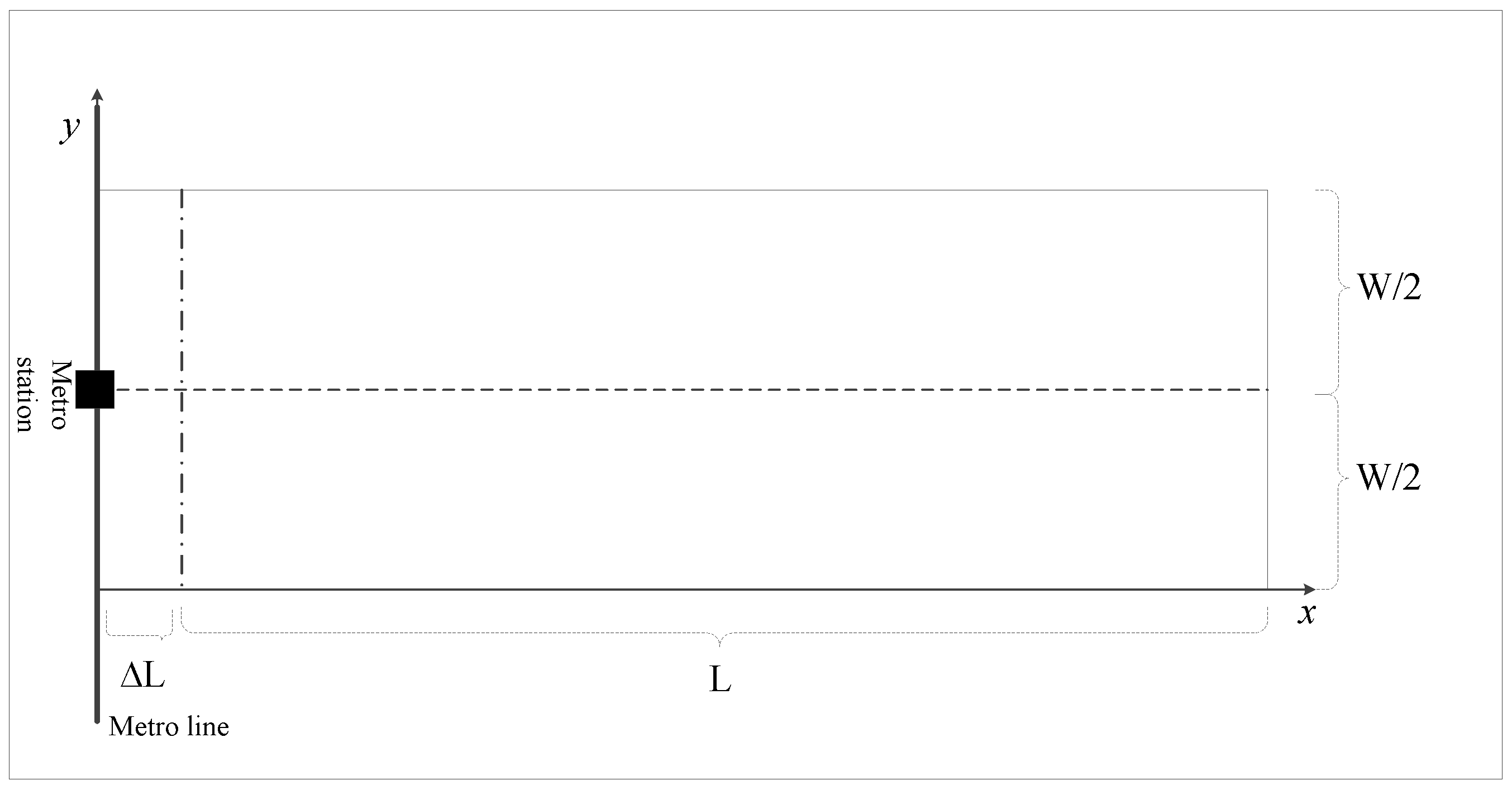


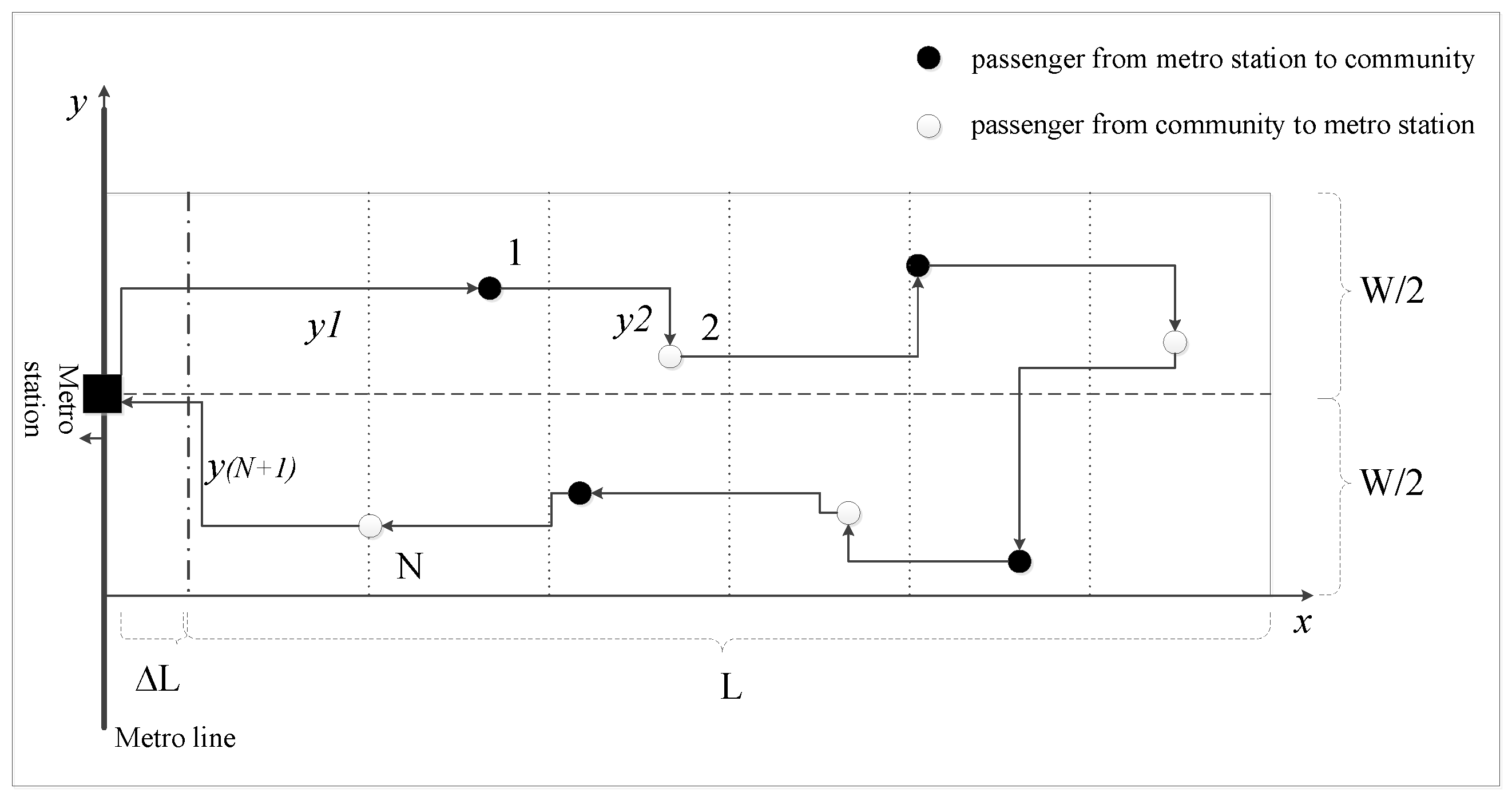
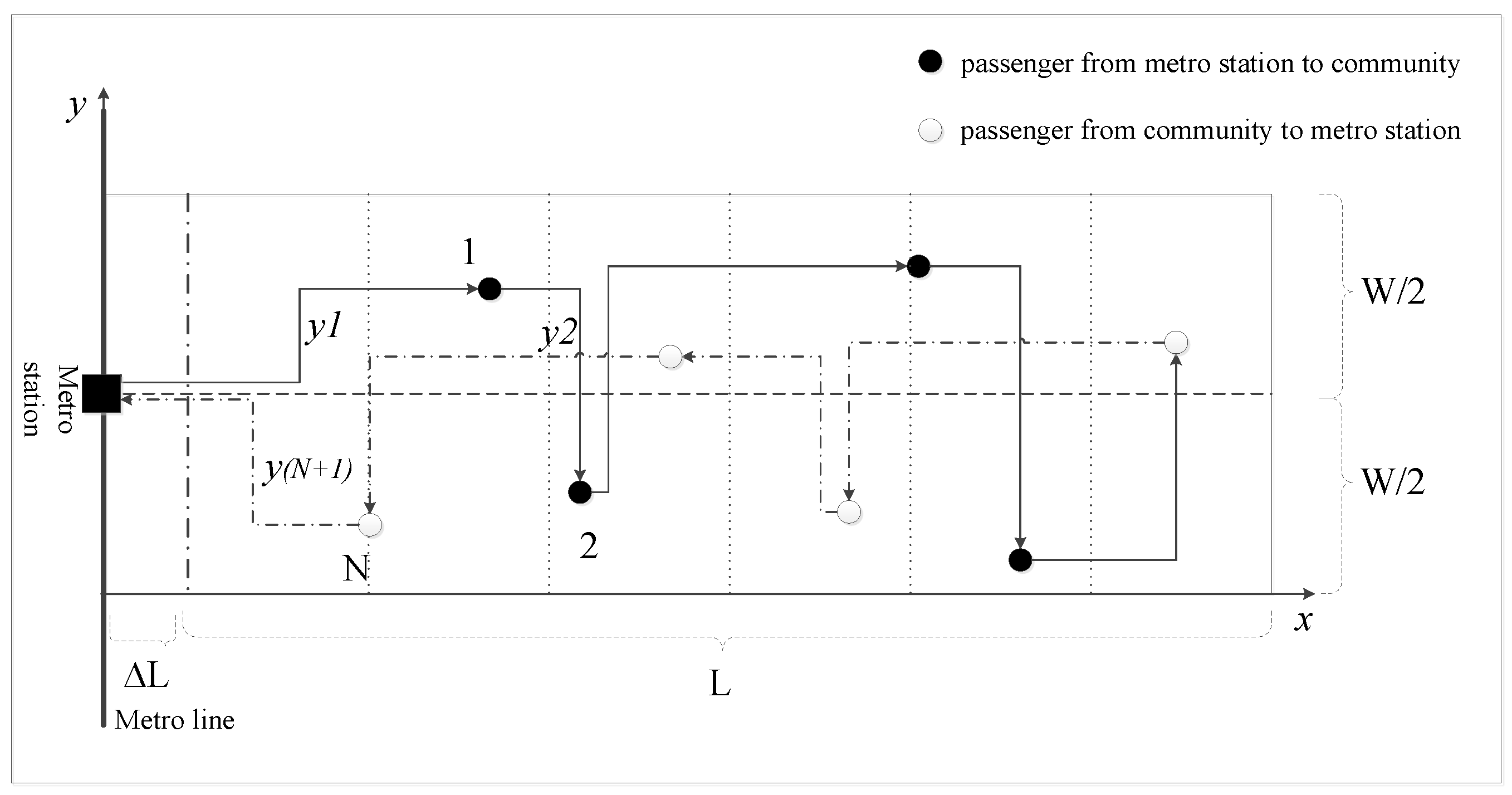

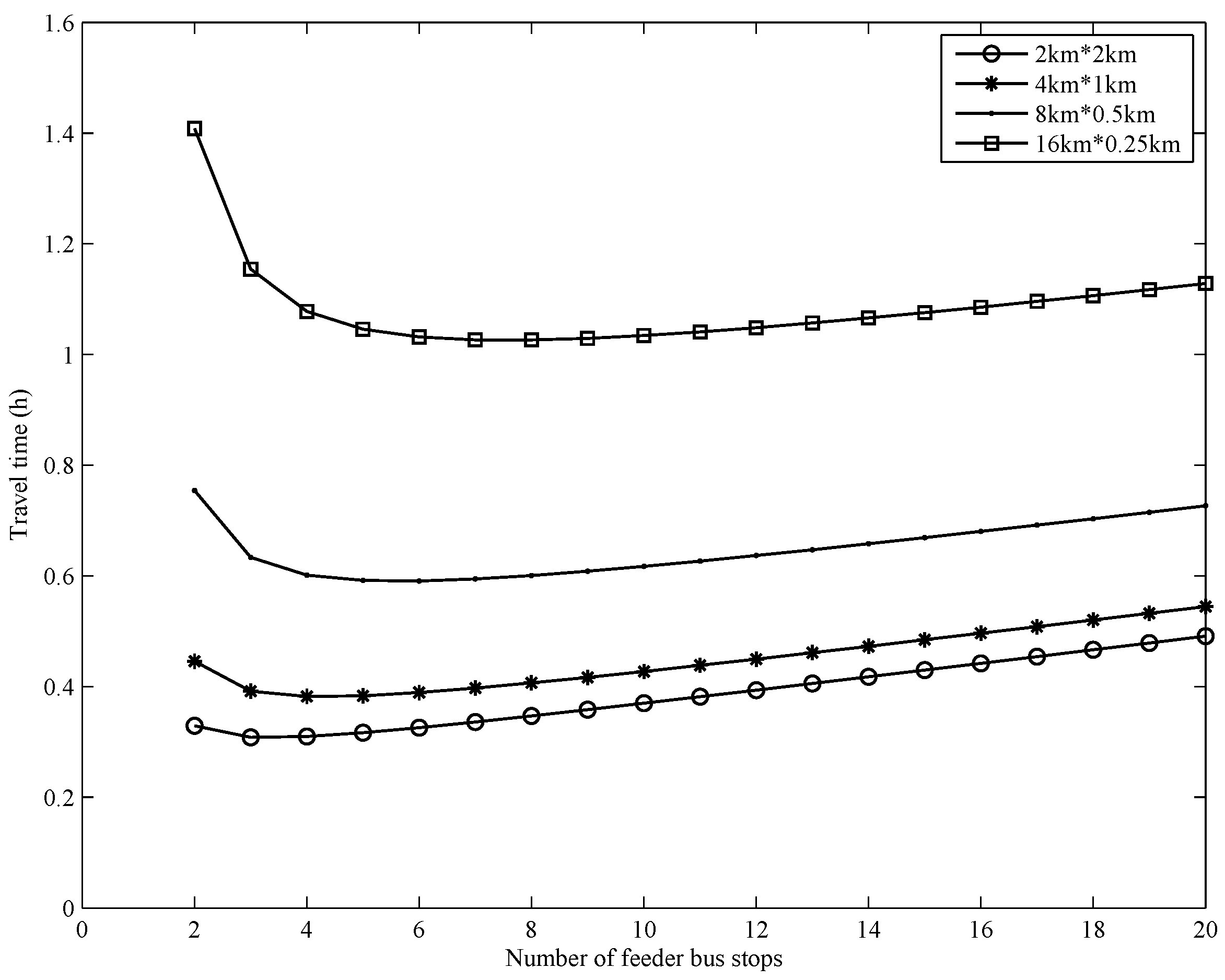
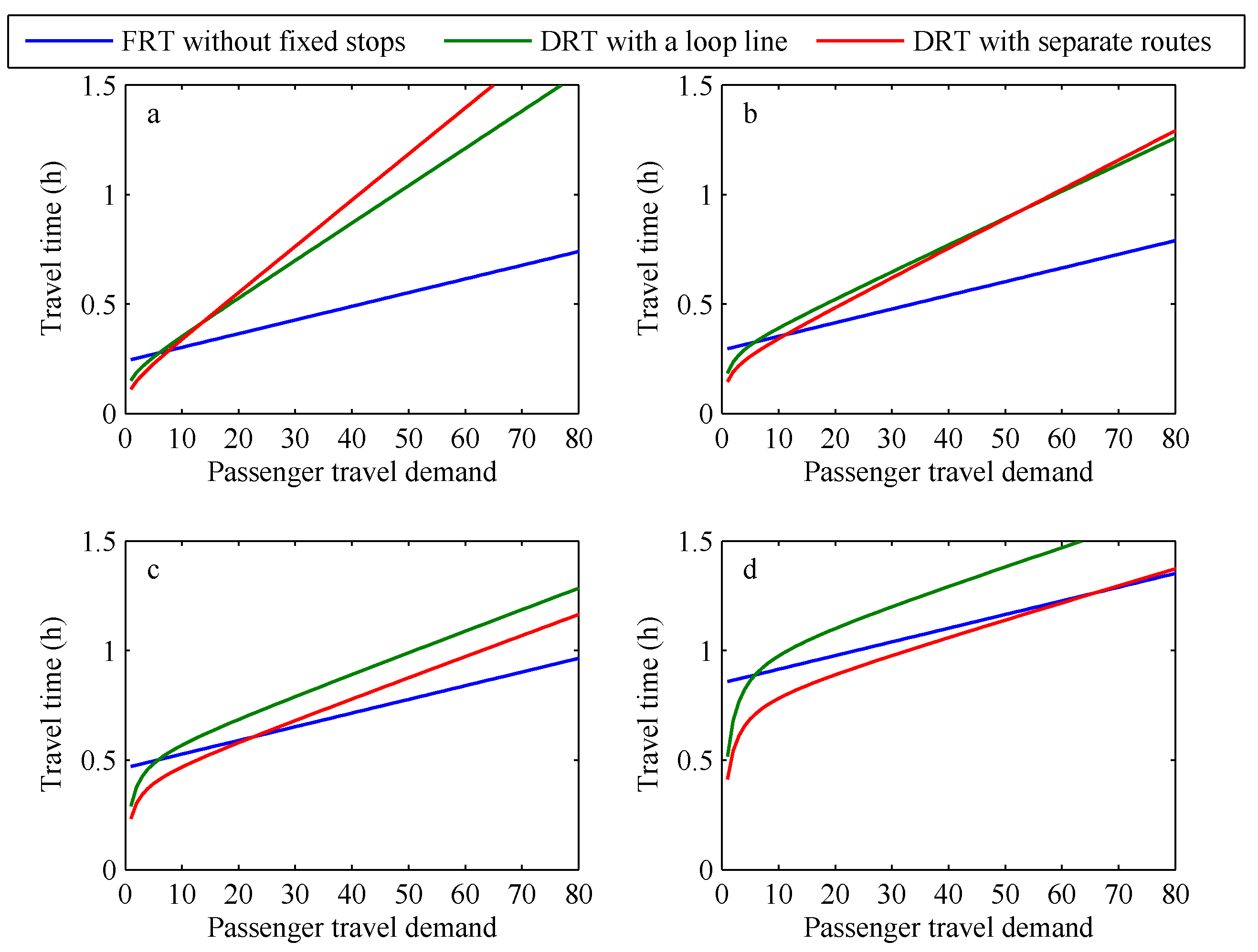
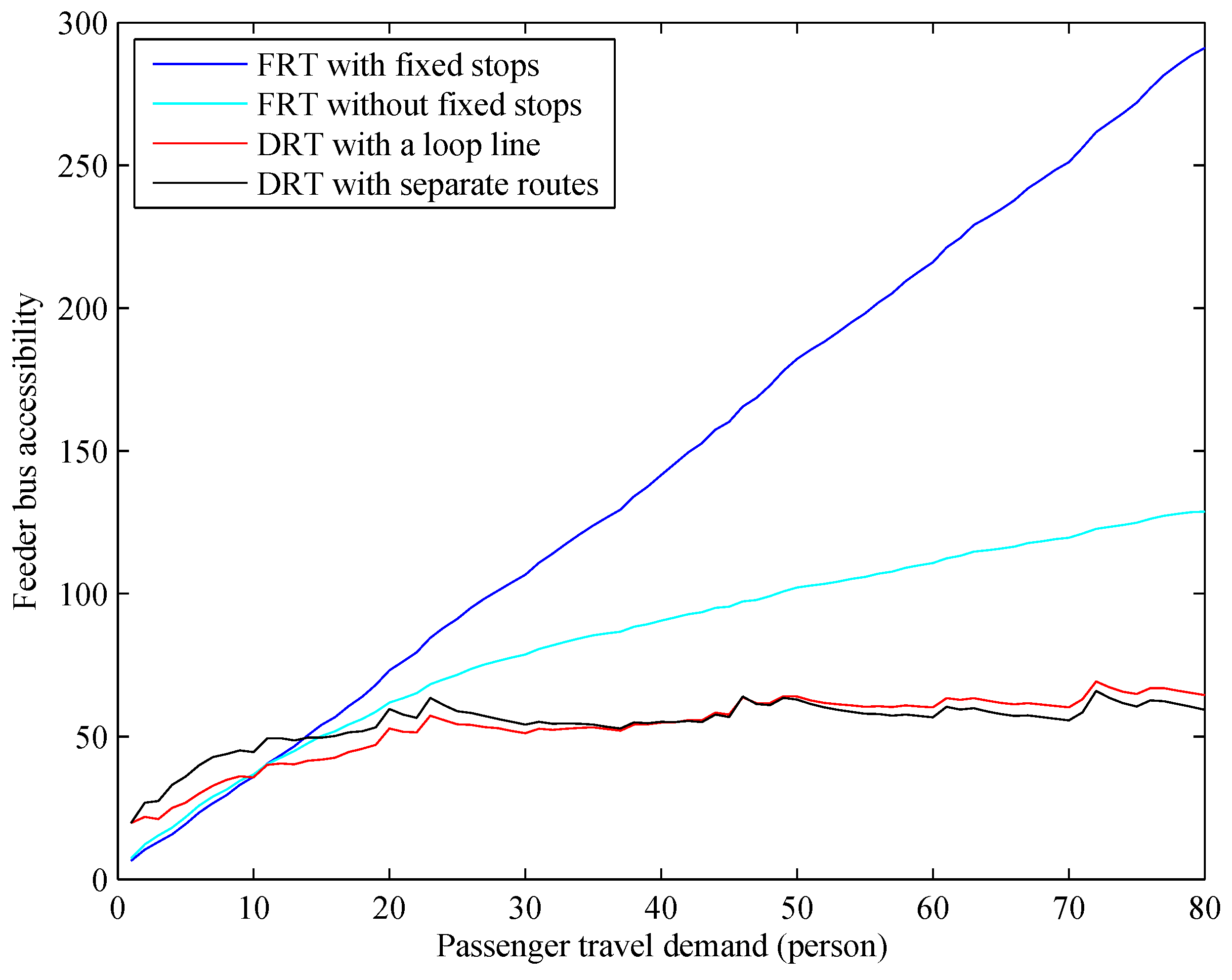

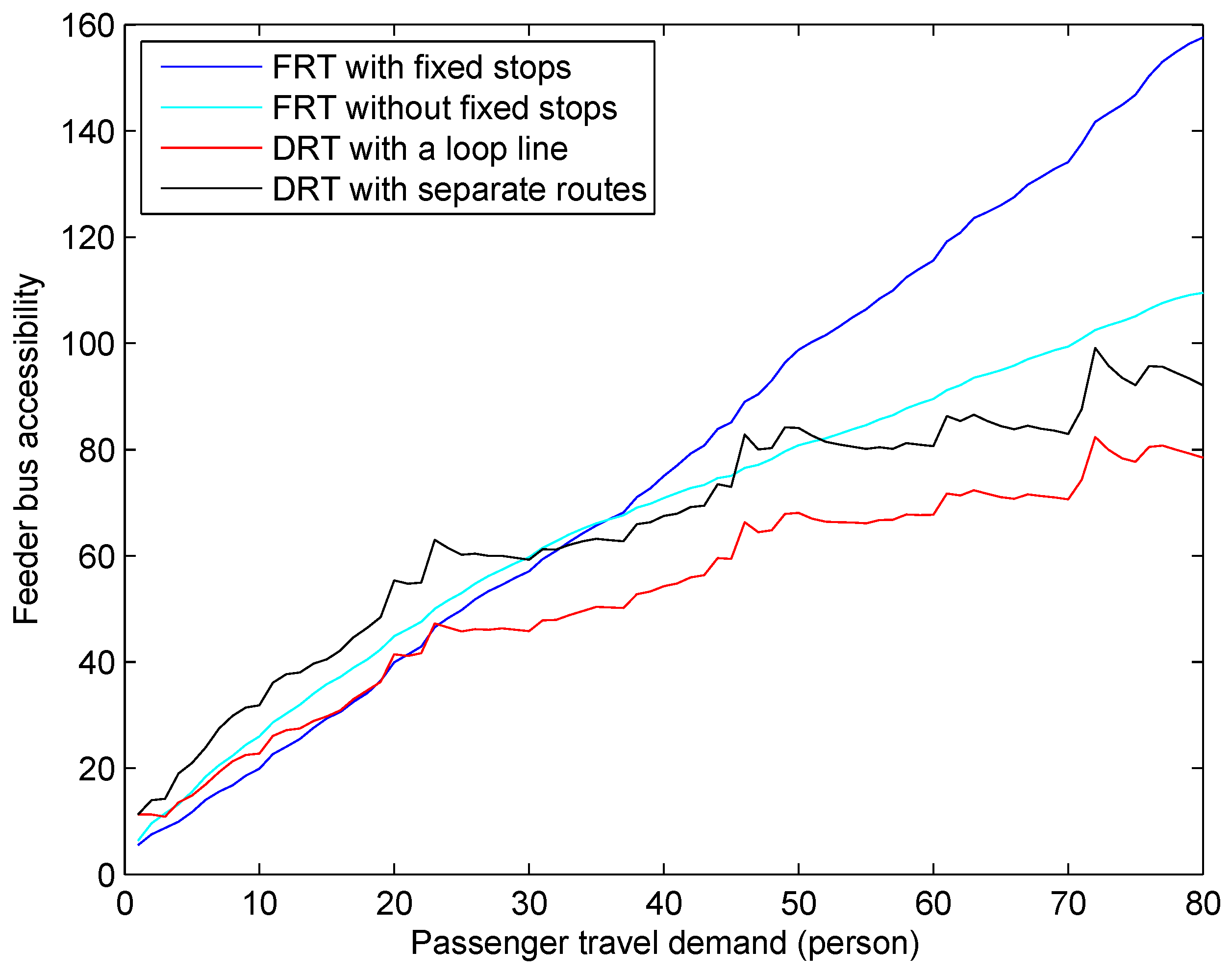

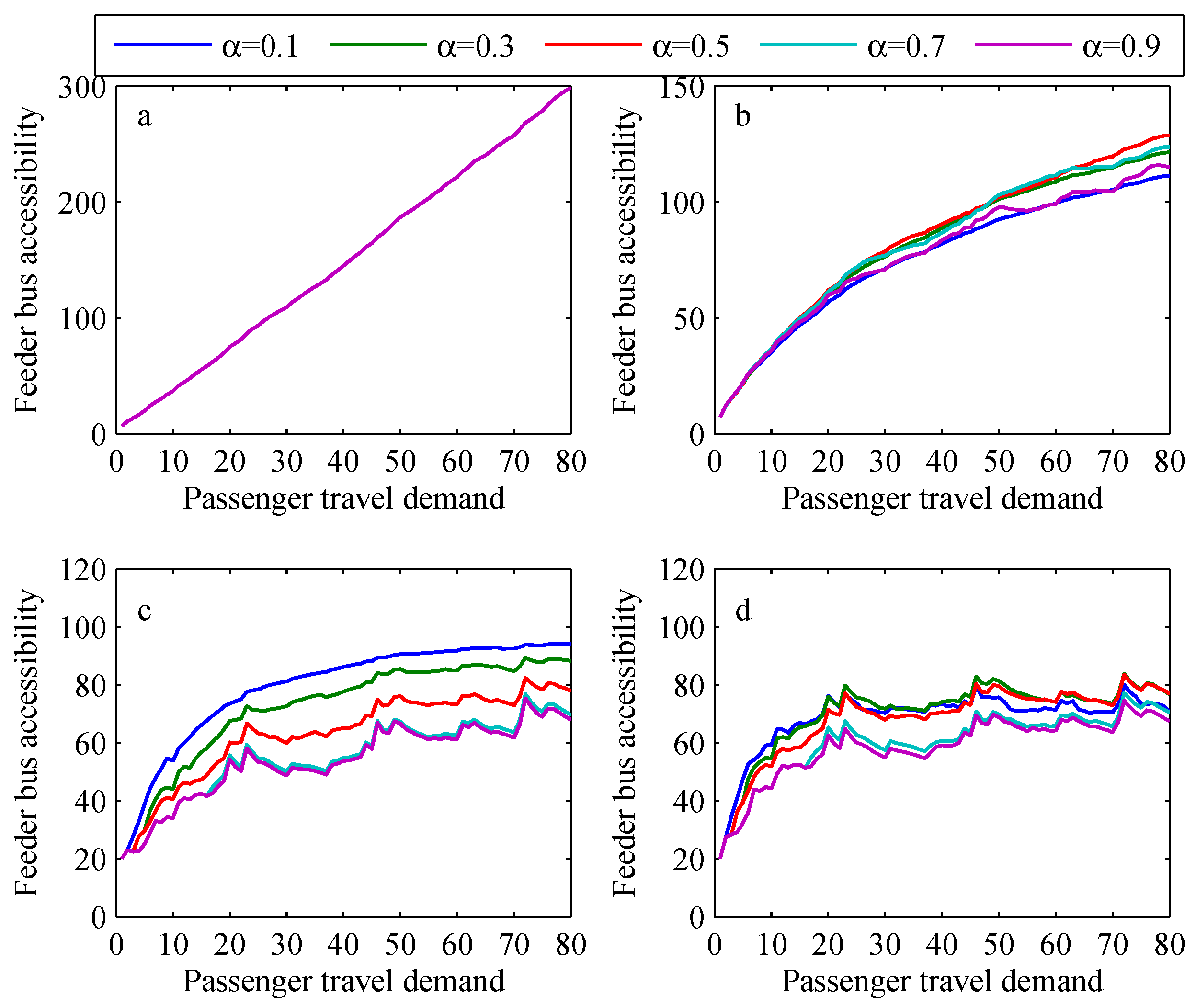
| Number of Stops | Walking Time | Waiting Time | Riding Time | Travel Time | |
|---|---|---|---|---|---|
| Case 1 | 3 | 0.150 | 0.088 | 0.071 | 0.309 |
| Case 2 | 4 | 0.117 | 0.157 | 0.108 | 0.382 |
| Case 3 | 6 | 0.105 | 0.303 | 0.183 | 0.591 |
| Case 4 | 8 | 0.127 | 0.574 | 0.325 | 1.026 |
Publisher’s Note: MDPI stays neutral with regard to jurisdictional claims in published maps and institutional affiliations. |
© 2020 by the authors. Licensee MDPI, Basel, Switzerland. This article is an open access article distributed under the terms and conditions of the Creative Commons Attribution (CC BY) license (http://creativecommons.org/licenses/by/4.0/).
Share and Cite
Jiang, S.; Guan, W.; Yang, L.; Zhang, W. Feeder Bus Accessibility Modeling and Evaluation. Sustainability 2020, 12, 8942. https://doi.org/10.3390/su12218942
Jiang S, Guan W, Yang L, Zhang W. Feeder Bus Accessibility Modeling and Evaluation. Sustainability. 2020; 12(21):8942. https://doi.org/10.3390/su12218942
Chicago/Turabian StyleJiang, Shixiong, Wei Guan, Liu Yang, and Wenyi Zhang. 2020. "Feeder Bus Accessibility Modeling and Evaluation" Sustainability 12, no. 21: 8942. https://doi.org/10.3390/su12218942
APA StyleJiang, S., Guan, W., Yang, L., & Zhang, W. (2020). Feeder Bus Accessibility Modeling and Evaluation. Sustainability, 12(21), 8942. https://doi.org/10.3390/su12218942






